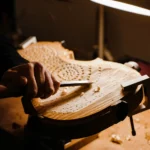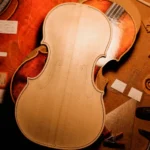6 Things To Help You Choose Your New Violin
Back to BlogChoosing your new violin can be a challenging process. This is due to many factors that include the violin’s shape, your budget, your goal as a musician, etc.
To figure out the kind of model, sound, and for what purpose you are acquiring a new instrument sounds a bit overwhelming. The violin is an extraordinary instrument and not a cheap one, and this decision needs attention, you want to be sure that the violin that you do choose will last and be one that you can bring with you through your musical career.
On that account, we brought together some of the tips from our experts to help make this decision easily.
1 Start by the reason why you are looking for a new violin
Are you in need of a new instrument, or are you just curious to try something different?
A typical student will only upgrade once every 3-4 years, but an ambitious motivated one may wish to upgrade more frequently. Upgrading to a better violin can be expensive, so make sure you know when is the right time to help you prepare for the costs.
There are three different string classifications: soloing, orchestral, and chamber music. Each has specific qualities that will determine an appropriate model.
2 Sound quality & the Ideal Tone
In the music world, it’s essential to know how you want your music to sound. Buying a new violin with the ideal tone may be the most important factor in selecting a violin.
An instrument of any kind needs to deliver top-quality sound for the musician to be happy with his or her purchase.
The internet offers access to an infinite amount of resources and info, our advice is to compare the sounds and listen to as many instruments and music as you can. This helps you to find what tone you are looking for. The result of a violin’s sound will be directly related to its model, for example, Strad models tend to have a brighter sound, while Guarneri’s a darker tone. Ensure you have your ideal sound in mind and look for a violin that will match with it and answer all your requirements.
3 Choose your model
In order to choose the right violin, you must be familiar with the different violin sizes. If you already play the violin, you will probably already understand the dimensions; if you are a student, look for help from your teacher.
Pay attention to the model features, the instrument’s models vary their measurements and fittings. It is important to be sure that the instrument’s size is appropriate for you. The correct size will vary according to your height and your arm length.
4 Modern or Old violins
This factor will mostly depend on how much you can invest in your new instrument. The modern violin has developed from a simpler predecessor over the last two centuries.
We can’t ignore the fact that the old master created marvelous instruments that are highly valued today. The thing is, though, not everybody can own a Stradivari, Guarneri, Amati. You must be aware of the options on the market today according to your budget.
Also, old instruments have unique sounds as well, the tone is already developed, and you know exactly how it will sound. However, with a new modern violin, you can have the chance to adapt and mold the sound to your taste and with years and practice it will only gets better.
5 The string length should fit correctly
Back to the measurements subject, it is important to confirm that the string length is within the standard range for your violin’s body. A string length outside the pattern will hinder playability since finger positions will change.
For full-size instruments, the standard range is 325 to 330 millimeters; make sure the string length is appropriate to your instrument and won’t hinder your playing.
6 Finding the right luthier for you makes the whole difference.
The relationship with your luthier is critical. When you find a luthier you are comfortable with, working together to create your own instrument can be a gratifying experience. A violin can be a piece of art that is constantly evolving like a diary with all the emotions, feelings, and uniqueness of its maker printed on it.
Start by finding a luthier who builds the type of instrument that you would like to purchase. It’s important to find someone who has experience building the instrument that you want to buy. The luthiers each have their own way of making, they tend to develop their own styles, influenced by their own design sensibilities and aesthetics.









